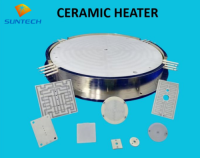Materials
It is madeup of Alumina, Zirconia, or other high-performance ceramics.
Features
- High Efficiency: Ceramic heaters offer high energy conversion efficiency, quickly converting electrical energy into heat with minimal loss, ensuring faster heating times.
- Durability: The robust ceramic materials used in these heaters are resistant to wear, high temperatures, and corrosive environments, providing long-term, reliable operation.
- Even Heat Distribution: Ceramic heaters provide uniform heat across their surface, reducing hot spots and ensuring even temperature distribution.
- High-Temperature Tolerance: Ceramic heaters can withstand high temperatures (up to 1000°C or more, depending on the material), making them suitable for a wide range of industrial and laboratory applications.
- Compact Design: The compact nature of ceramic heaters allows them to be used in tight spaces, offering a versatile solution for both large and small heating applications.
- Instant Heat Response: Due to the high thermal conductivity of the ceramic material, these heaters can rapidly adjust to desired temperatures with minimal lag.
Applications
- Industrial Heating: Used in furnaces, kilns, and drying systems for applications that require uniform heating, such as in the manufacturing of metals, glass, or ceramics.
- Electronics and Semiconductor Processing: Employed in precise temperature control during processes like soldering, annealing, or curing in semiconductor manufacturing.
- Home Appliances: Commonly found in space heaters, toasters, and hairdryers, where quick and consistent heat is needed.
- Medical Equipment: Used in incubators, sterilizers, and other devices requiring regulated heat to maintain sterile or safe conditions.
- Automotive: In applications like seat heaters or defrosters where efficient and controlled heating is crucial.

